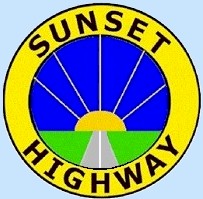
The Historic Sunset Highway
in Washington
Wenatchee to Coulee City

The Historic Sunset Highway
in Washington
Wenatchee to Coulee City
Description of the Route
When travelers reached Wenatchee, they would cross over the Columbia again on the Old Wenatchee Bridge that was built in 1908. This bridge and still stands today and is used as a pedestrian bridge. After crossing the bridge the route continues in a northern direction to the town of Orondo.
At Orondo, you turn right to go up Corbaley canyon towards Waterville. Going up the canyon, you turn onto Badger Mountain Rd. This is the old route up the hill. The road is good all the way up past the second switchback then the road is blocked.
The rocks falling from the cliffs have made the road impassable from there. Just turn around and head back to the new road, and continued into Waterville. At the top of the hill there was an old abandoned farmhouse and a old time billboard painted on a barn.
In Waterville stop and take some photos of the Old Waterville Hotel. The hotel was built in 1903 and I am sure it served many tourists travelling along the Sunset Highway. They are opening the rooms for business in the spring for the season.
It is great to see the old hotel still in business. There is an old wagon road that went up the canyon south of the old route to Waterville. This route shows up on the 1915 maps. You can see the route on the map.
In 1915 as travelers left Waterville for Coulee City, they would have driven over relatively flat terrain for fifteen miles with nothing but scrub land and wheat fields. The road was a straight line except for a curve around the Mansfield Branch of the Great Northern Railway.
Douglas and Farmer were the only towns along this stretch even though they were two miles south of the highway. After the fifteen mile drive they would turn right and drive another two miles in a straight line before they would reach the picturesque Moses Coulee.
In 1918 the highway was improved and rerouted SE from Waterville to Douglas following the Waterville Railway. From Douglas it went up the hill and eastward to Farmer and on to the Moses Coulee.
Moses Coulee cuts into the Waterville plateau Between Coulee City and Waterville. The mouth of the Coulee discharges into the Columbia River at the Great Gravel Bar, a National Natural Landmark which was designated a landmark because it is one of the largest examples of bars created by outburst floods of Lake Missoula over the Channeled Scablands of Washington.
Like the terrain of the Big Bend counties that surround it, massive floods during the waning of the Ice Age shaped the land that is now Douglas County, forming deep canyons (coulees). The coulee floor lies some 500 feet down, surrounded by basalt cliffs.
On the west side of the coulee you can still drive the abandoned part of the old highway (if you are adventurous) down to the bottom. You have to take a dirt road (which is not very good) at the bottom to reconnect with the new road. The ghost town of Spencer is at the bottom of the coulee.
The first telephone line from Coulee City to Waterville was built in 1901 or 1902. You can still see many of these poles still in place after over 100 years.
The original road followed these poles going up the east side of the coulee and continued alongside the poles for about 9 miles before the road turned south.
This is where the 1918 road meets the original road. From here today's Hwy 2 follows in the path of the original road to the hillside 3 miles before Coulee City. Going down the hill Hwy 2 is on a smoother alignment and there is plenty of places to see the old road.
At the bottom of the hill and before you cross over the Dam, Turn right onto Highway 17 for a two mile side trip to the Dry Falls. Dry Falls is one of the great geological wonders of North America.
Carved by Ice Age floods that long ago disappeared, the former waterfall is now a stark cliff, 400 feet high and 3.5 miles wide. In its heyday, the waterfall was four times the size of Niagara Falls. Today, it overlooks a desert oasis filled with lakes and abundant wildlife.
Back to the highway you now cross over Dry Falls Dam, which is a rock faced earth fill-type dam completed in 1949. It was built as part of the Bureau of Reclamation's Columbia Basin Project. The 1915 and 1920's route both are under water behind the dam.
Once you are across the dam you arrive in Coulee City.